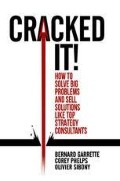Abstract
Walking the audience through PowerPoint slides is both the most frequent and the least efficient way to deliver recommendations. The challenge is to steer a productive conversation with problem owners in which visual aids do not become visual impediments. Telling relevant stories and using striking examples can help. Handing out a neat and concise recommendation report is mandatory. The report must start with an executive summary and follow the storyline. If it takes the form of a slide deck, it must feature only one message per page. You can present supporting evidence with charts that you must keep relevant and simple. The chapter discusses various types of charts and templates, as well as guidelines to check and improve your presentations.
Access this chapter
Tax calculation will be finalised at checkout
Purchases are for personal use only
Notes
- 1.
Rasiel , E.M. (1998). The McKinsey Way. New York: McGraw-Hill.
- 2.
This model is based on fictitious data.
- 3.
Zelazny, G. (2001). Say it with Charts (4th edition). New York: McGraw-Hill.
- 4.
Given this objective, it makes senses to use “100%” bars and to show the percentages in each column , as in Fig. 11.9. Such charts are prone to misinterpretation, however, as a declining percentage of a growing whole can occur even when the absolute value of the item increases, and vice versa. To avoid such confusion, it is indispensable, at a minimum, to mention the “100%” total value at the top of each bar. In some cases, you may want to resort to stacked columns in absolute values, which make the contributions of components harder to compare, but are more faithful to reality since they are not distorted by being converted to percentages.
- 5.
BCG has become famous by producing charts that showed, in industry after industry, that this correlation held. Accordingly, this is a case in which correlations support an explicit theory. However, when using this type of chart without such a preexisting theory, keep in mind the dangers of taking correlation for causal evidence, as we discussed in Chap. 7.
- 6.
See, for instance, presentations by the late Hans Rosling. Retrieved from https://www.ted.com/speakers/hans_rosling.
- 7.
Tufte, E. (2006). The Cognitive Style of PowerPoint: Pitching Out Corrupts Within. Cheshire, Connecticut: Graphic Press.
- 8.
Heath, C., & Heath, D. (2007). Made to Stick: Why Some Ideas Survive and Others Die. New York: Random House.
- 9.
Stone, M. (2015, July 28). A 2004 email from Jeff Bezos explains why PowerPoint presentations aren’t allowed at Amazon. Business Insider France. Retrieved from http://www.businessinsider.fr/us/jeff-bezos-email-against-powerpoint-presentations-2015-7/.
Author information
Authors and Affiliations
Rights and permissions
Copyright information
© 2018 The Author(s)
About this chapter
Cite this chapter
Garrette, B., Phelps, C., Sibony, O. (2018). Sell the Solution: Recommendation Report and Delivery. In: Cracked it!. Palgrave Macmillan, Cham. https://doi.org/10.1007/978-3-319-89375-4_11
Download citation
DOI: https://doi.org/10.1007/978-3-319-89375-4_11
Published:
Publisher Name: Palgrave Macmillan, Cham
Print ISBN: 978-3-319-89374-7
Online ISBN: 978-3-319-89375-4
eBook Packages: Business and ManagementBusiness and Management (R0)

